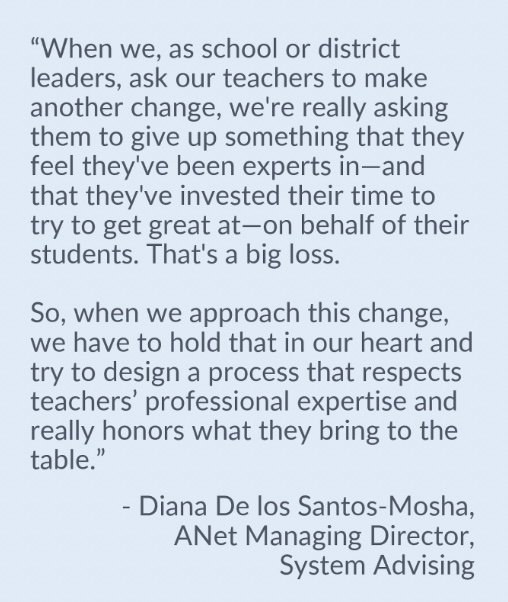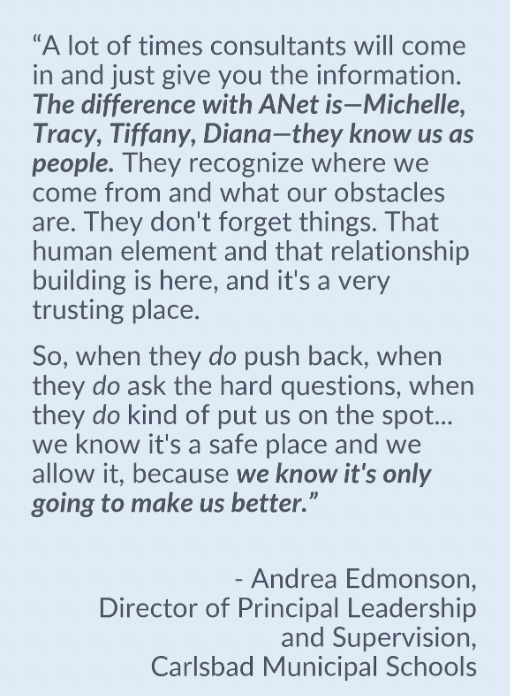Carlsbad and ANet have worked together since the 2018-19 school year when Carlsbad joined a small cohort of schools as an ANet Breakthrough Results Study partner.
Carlsbad Municipal Schools is a school district in Southeastern New Mexico, serving nearly 7,000 students across 15 schools. Carlsbad has been working to remedy persistently low math performance; their targets include low math performance across all students, as well as larger performance gaps between lines of economic difference. To support these efforts, and as part of a seven-year, state-legislated adoption cycle, the district selected new instructional materials in Spring 2020. They began implementing their new materials in the following school year and are now launching a district-level department focused on supporting strong instruction across schools.
Results:
Just a few years ago, instruction was not a focus in Carlsbad—yet now, they’ve completely changed course. Strong instruction is a top priority and the district is taking a system-wide approach to equip teachers and students with the right materials and support for grade-level learning. Key wins along the way include:
-
Strong district and community buy-in during the curriculum selection process
-
Implementation of a new mathematics curriculum
-
The launch of their first-ever district instructional department
Read on to learn about Carlsbad’s curriculum selection process, first year of implementation, and the beginnings of their newly-created instructional department.
Creating strong buy-in during the curriculum selection process:
Setting the right targets, identifying clearly-defined roles, and prioritizing a transparent process helped ensure a successful curriculum adoption with strong community support.
Carlsbad Deputy Superintendent LaVern Shan has worked in the district for over 15 years and understands the community’s strengths and struggles. She acknowledges that, for a while, “academics were not a focus” in Carlsbad. But when then-Superintendent Dr. Greg Rodriguez joined Carlsbad Municipal Schools in 2017, he shifted the district in a standards-based, instructionally-focused direction. He helped to launch the Carlsbad/ANet partnership the following year, joining a small cohort of schools as a Breakthrough Results Fund partner. And when the district had the opportunity to select a new mathematics curriculum through a state-legislated adoption cycle in 2019, new Superintendent Dr. Gerry Washburn, LaVern Shan, and their fellow district leaders looked to ANet to help design a thoughtful curriculum selection process.

ANet’s Diana De los Santos-Mosha, who supported the Carlsbad district team through the selection process, shares that they wanted to avoid simply “going through the motions” of picking a new curriculum from the list that the state provided. Instead, district leaders and the ANet team first stepped back to consider how prior initiatives have been met in the district, asking what caused them to fall flat or what helped them be an accelerant for student performance. “And what we learned,” Mosha notes, “is that new initiatives often fell flat because there was a gap in trust.” With that recognition, they anchored in a change management approach designed to build trust and honor educators’ expertise.
Because the team understood that building trust was critical, it was important to find an intentional seat at the table for all constituents. Each member of the adoption team—composed of teachers on the selection committee, the district team, the ANet team, and the broader Carlsbad community—had a clearly defined role in the process. ANet’s role, for example, focused primarily on bringing content expertise and an external view to coordinate and facilitate sessions.

Elaborating further on the role distinctions, Mosha explains, “I think sometimes in schools there's a feeling of hierarchy, but we wanted to put teachers’ voices at the center, with the additional support of school leaders and the district team thinking about what's practical for their community.”

Eric Spencer, director of secondary education at Carlsbad Municipal Schools, participated in the selection process and noticed the impact of the approach. “The number one benefit of the process,” he reflects, was that “ANet brokered the conversation between administrators and teachers” so that they could participate as equals in the experience. He also notes they were all “kept to task on focusing on the evidence” and they successfully came to a consensus on the vision for the mathematics curriculum.
“Looking forward, when it’s time to adopt materials again, we will replicate the process and wholeheartedly implement it,” Spencer says. “We would, however, expand in one area. While teacher leaders were to lead their building level teams in the adoption process and surveys were conducted to ensure the gathering of teacher voice, we would consider assigning coaches to our teacher leaders to support them in facilitating full participation at the building level so that every teacher participates in the insight-based activities related to the process.”
Throughout the process, the Carlsbad/ANet team prioritized transparency. The calendar was outlined before the selection process began, and it was made publicly available to teachers, families, the board, and others to ensure every stakeholder understood what was happening. The district shared regular updates with the broader community as well.

Stacy Rush is the Principal at Carlsbad’s Early College High School. She notes that a K-12 math curriculum adoption is a “huge” undertaking, but, she says, “because our teachers were involved, there was so much more buy-in.” She believes starting with a large sample of options and having teachers so heavily involved in decision-making helped maintain buy-in, too, because the teachers involved could articulate to others the extensive review process which led to their ultimate decision.
Indeed, the district-wide support was so clear and strong that the School Board unanimously approved the curriculum selection.
Implementing a new curriculum:
Despite COVID-19 hurdles, including navigating remote and hybrid instruction, Carlsbad staff began implementing the new curriculum during the 2020-21 school year, honoring the selection committee’s decisions and—for the first time—providing grade-level instruction to all students.
When asked about their decision to stay the course, rolling out a brand new math curriculum during the COVID-19 pandemic, Deputy Superintendent LaVern Shan is confident in the choice they made. She says she considered the amount of work teachers undertook to prepare for the adoption; she also knew teachers felt deep attachments to the decisions they made and the recognition they were moving toward more equitable instruction for kids. Lastly, she adds, they had no curriculum to fall back on. Amidst this all, Shan feels clear: “We had no option but to move it forward.” And so, while navigating through remote learning and then various phases of reentry, Carlsbad math teachers began a new curriculum.

Of course, it wasn’t simple. Andrea Edmonson, director of principal leadership and supervision, points out that, at the time, teachers were “learning in the virtual world themselves.” Like their students, teachers were navigating the new, virtual environment after years of in-person learning and development. Given this challenge—and many other hurdles of the pandemic—they started small; early on, the district’s primary focus was ensuring teachers were accessing the curriculum, and that school and system leaders could engage in virtual classroom walk-throughs and look for elements of the curriculum.
Diana De los Santos-Mosha points out this strategy is something she has learned from her work with Carlsbad and now tries to bring to her work with other ANet partners. When it comes to utilizing data, Mosha notes that assessments are just one piece to consider, “but as Andrea described, conducting observations is another tool; usage data is another tool. Follow what the numbers say to drive implementation.”
Principal Stacy Rush shares, now, for the first time in years, she observes consistent and grade-level instruction across classrooms: “You could go into several Algebra I classrooms, for example, and you would see they were in the same place. Finally, we had coherence and consistency.” Looking beyond their initial usage goal, Rush credits ANet’s coaching support and resources for helping to bring clear, tangible changes to the quality of instruction.
To help achieve this change, ANet school coach Tracy Glenn worked directly with the high school leadership team, preparing leaders to observe math instruction as a way to provide teachers with valuable and standards-aligned feedback. Glenn also helped leaders deepen their understanding of the standards and understand the aspects of rigor. She supported leaders to "do the work" themselves and build the instructional expertise that helped deepen trust with teachers. Reflecting on Glenn’s coaching support, Principal Rush shares, “Tracy was amazing with walking us through instructional observations and working with our teachers [to understand] rigor—it doesn’t just mean hard work or more work; there are aspects of rigor that we need to analyze, and pinpoint, and have action steps. These are things that just weren’t even in the vocabulary of our [leaders and] teachers before!”
Launching a new instructional department:
Previously, just a few district-level individuals handled all questions related to schools. Moving forward, a new, central department will be reorganized under “Instruction”—meaning its primary focus is supporting rigorous, grade-level learning across schools.

Carlsbad leaders are excited to see greater coherence and a deeper focus on instructional support in the coming year. Andrea Edmonson shares, “when [ANet] first teamed up with us, we did this instructional audit and we were learning, district-wide, how disconnected we were. Our students, if they went from one elementary to another, it was another inequity; they were not getting the same thing at both campuses.” Their central office structures were inefficient as well, she notes; many meetings were spent discussing and building frameworks so information could be shared across school sites. But without the right structures in place to intuitively disseminate information, leaders often needed to seek it out themselves. “I think we’ve come a long way in this three year period,” Edmonson reflects, “really turning around the district and making sure that all of our arrows are pointing in the same direction.”
LaVern Shan shares that, moving into the 2021-22 school year, they have reorganized their district office under “Instruction”—an administrative shift designed to direct greater focus and energy to instructional support at a system level. Previously, just two directors and Shan were available to support schools at the district level. They are now launching an instructional leadership development team and a curriculum support team to prioritize the needs they were seeing across the district. Starting this school year, all system leaders will play a role in prioritizing strong instruction, utilizing their individual strengths. They are bringing on new staff, as well, including, for the first time, a bilingual and equity director. Carlsbad’s partnership with ANet, Shan says, has helped the district focus on a systemic approach to instruction, ultimately leading them to this reorganization.

In the coming year, Carlsbad teachers and leaders will have much on their plates. Even so, their ANet team is confident in their abilities to navigate any upcoming challenges: Diana De los Santos-Mosha credits their successes thus far to hard work and centering their day-to-day decisions on kids. Tracy Glenn observes how leaders are “rolling up their sleeves to do the work alongside their teachers” and are “embracing ‘courage over comfort.’” Likewise, Tiffany Alvarez Smith—who leads ANet’s work with the Breakthrough Results Fund cohort and works closely with the Carlsbad team—shares that Carlsbad leaders have a “willingness to be vulnerable” which has shaped their growth immensely, and will continue to benefit them in their development as instructional leaders.
And from Carlsbad leaders’ perspectives, they are motivated as they kick off a new school year. While the COVID-19 pandemic has introduced new and greater challenges to the district, Deputy Superintendent Shan emphasizes that every year, students come in at various levels. “This year,” she asserts, “isn’t going to be any different.” She and her team are ready to tackle the work ahead, focusing on strengthening math instruction throughout the district and emulating the process for an ELA curriculum adoption.
This material is licensed for use under the CC-BY-NC-ND license
© 2024 The Achievement Network, Ltd.
To learn more about ANet, visit us at achievementnetwork.org
Want to learn more about the improved student outcomes that resulted from ANet’s Breakthrough Results Study?
Check out our findings from the multi-year study at ANetGetsResults.org.
